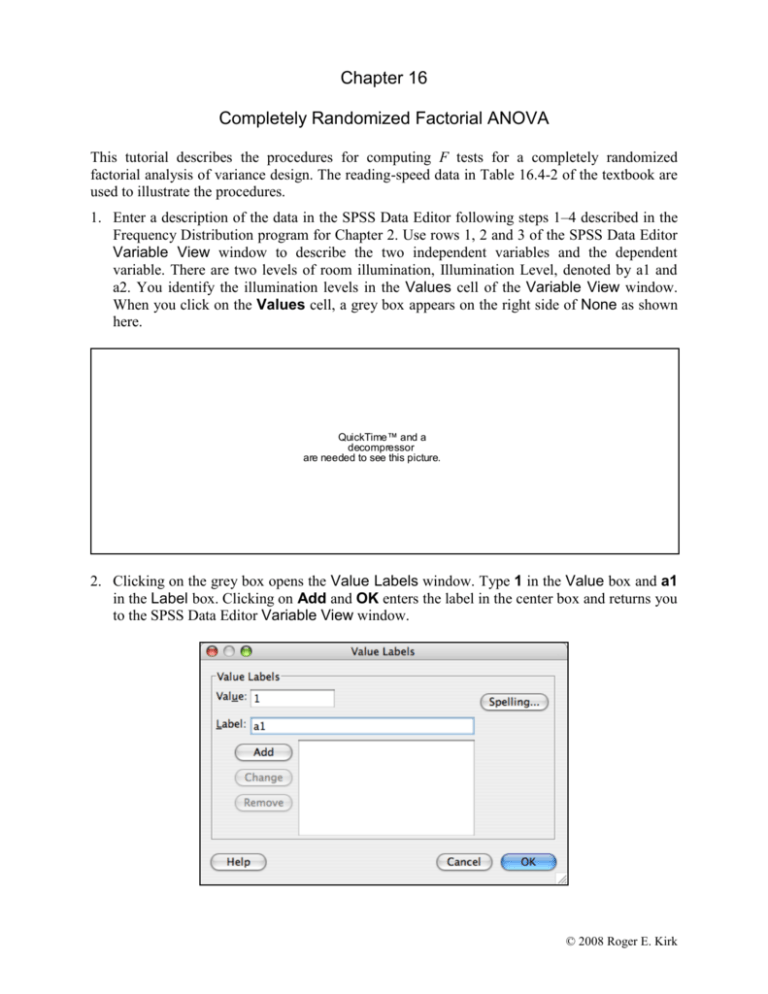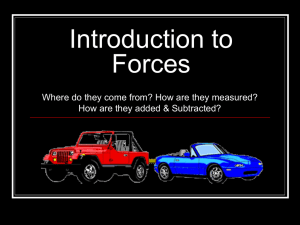Chapter 3
advertisement

Chapter 16 Completely Randomized Factorial ANOVA This tutorial describes the procedures for computing F tests for a completely randomized factorial analysis of variance design. The reading-speed data in Table 16.4-2 of the textbook are used to illustrate the procedures. 1. Enter a description of the data in the SPSS Data Editor following steps 1–4 described in the Frequency Distribution program for Chapter 2. Use rows 1, 2 and 3 of the SPSS Data Editor Variable View window to describe the two independent variables and the dependent variable. There are two levels of room illumination, Illumination Level, denoted by a1 and a2. You identify the illumination levels in the Values cell of the Variable View window. When you click on the Values cell, a grey box appears on the right side of None as shown here. QuickTime™ and a decompressor are needed to see this picture. 2. Clicking on the grey box opens the Value Labels window. Type 1 in the Value box and a1 in the Label box. Clicking on Add and OK enters the label in the center box and returns you to the SPSS Data Editor Variable View window. © 2008 Roger E. Kirk Completely Randomized Factorial ANOVA 2 3. In the Variable View window, click on the Value cell to see the grey box. Click on the grey box to return to the Value Labels window where you identify the second level of the illumination variable. Type 2 in the Value box and a2 in the Label box. Click on the Add button and then the OK button to return to SPSS Data Editor Variable View window. 4. Use the second row of the SPSS Data Editor Variable View window to describe the second independent variable: size of type, denoted by Type Size. This variable has three levels denoted by b1, b2, and b3. You identify the levels of the variable in the Values cell of the Variable View window. When you click on the Values cell, a grey box appears. Clicking on the grey box opens the Value Labels window. Type 1 in the Value box and b1 in the Label box. Repeat the process for the second and third levels of the size-of-type variable. The Value Labels window should appear as shown here. SPSS automatically inserts the equal sign and the quotation marks after you type b3 in the Value Label box. Click on the OK button in the lower right part of the window to return to the SPSS Data Editor Variable View window and finish filling out the cells in the second row. 5. Use row 3 of the SPSS Data Editor Variable View window to describe the dependent variable, denoted by R_speed. The SPSS Data Editor Variable View window should be similar to the window shown here. QuickTime™ and a TIFF (LZW) decompressor are needed to see this picture. 6. Click on the SPSS Data Editor Data View button to enter the data. Type 1 or 2 in the I_level column; 1, or 2, or 3 in the T_level column; and the reading score in the R_speed column. © 2008 Roger E. Kirk Completely Randomized Factorial ANOVA 3 7. To compute ANOVA F statistics, click on Analyze in the Menu Bar; select General Linear Model from the pull-down menu and then Univariate. These selections open the Univariate window in which you specify which variables are the independent and dependent variables. QuickTime™ and a TIFF (LZW) decompressor are needed to see this picture. 8. Select Illumination Level (I_level) and click on the arrow beside the Fixed Factor(s) box. The independent variable, Illumination Level (I_level), will appear in the Fixed Factor box. Select Type Size (T_level) and click on the arrow beside the Fixed Factor(s) © 2008 Roger E. Kirk Completely Randomized Factorial ANOVA 4 box. The second independent variable, Type Size (T_level), will appear in the Fixed Factor box. Select Reading Speed (R_speed) and click on the arrow beside the Dependent Variable box. The dependent variable, Reading Speed (R_speed), appears in the Dependent List box as shown here. QuickTime™ and a TIFF (LZW) decompressor are needed to see this picture. 9. Click on the Post Hoc button in the Univariate window to open the Univariate: Post Hoc Comparisons for Observed Means window. © 2008 Roger E. Kirk Completely Randomized Factorial ANOVA 5 QuickTime™ and a TIFF (LZW) decompressor are needed to see this picture. 10. The independent variable, T_size, has three levels. To obtain Tukey’s multiple comparison procedure for this variable, select T_size in the Factor(s) box and click on the arrow between the Factor(s) box and the Post Hoc Tests for box. T_size will appear in the Post Hoc Tests for box. Next, click on Tukey to select this multiple comparison procedure. The preferred procedure, Fisher-Hayter statistic, is not an option in SPSS. When the n’s are equal, the Tukey and Fisher-Hayter statistics are equal. You can compute the Fisher-Hayter statistic from the information in the ANOVA and Multiple Comparisons tables given later. The Fisher-Hayter statistic can be referred to the Fisher-Hayter table in your textbook to obtain a slightly more powerful test. Click on the Continue button to return to the Univariate window. 11. In the Univariate window, click on the Options button to bring up the Univariate: Options window shown here. © 2008 Roger E. Kirk Completely Randomized Factorial ANOVA 6 QuickTime™ and a decompressor are needed to see this picture. 12. Select (Overall) in the Factor(s) and Factor Interactions box and click on the arrow beside the Display Means for box. This moves (Overall) into the Display Means for box. Repeat the procedure for I_level, T_size, and I_level*T_size. Next, click on the Descriptive Statistics box, Estimates of effect size box, and the Homogeneity tests box. Then click on the Continue button to return to the Univariate window. Click on the OK button in the Univariate window to obtain the ANOVA output shown here. QuickTime™ and a TIFF (LZW) decompressor are needed to see this picture. © 2008 Roger E. Kirk Completely Randomized Factorial ANOVA 7 QuickTime™ and a TIFF (LZW) decompressor are needed to see this picture. QuickTime™ and a TIFF (LZW) decompressor are needed to see this picture. QuickTime™ and a TIFF (LZW) decompressor are needed to see this picture. QuickTime™ and a TIFF (LZW) decompressor are needed to see this picture. QuickTime™ and a TIFF (LZW) decompressor are needed to see this picture. © 2008 Roger E. Kirk Completely Randomized Factorial ANOVA 8 QuickTime™ and a TIFF (LZW) decompressor are needed to see this picture. QuickTime™ and a TIFF (LZW) decompressor are needed to see this picture. QuickTime™ and a TIFF (LZW) decompressor are needed to see this picture. QuickTime™ and a TIFF (LZW) decompressor are needed to see this picture. © 2008 Roger E. Kirk Completely Randomized Factorial ANOVA 9 13. The Between-Subjects Factors window displays the number of observation in each level of the two independent variables. The Descriptive Statistics window displays the mean, standard deviation, and sample size for each combination of the two treatments. Levene’s Test of Equality of Error Variances window indicates that the homogeneity of variance assumption is tenable. The ANOVA F tests are reported in the Tests of Between-Subjects Effects window along with p values, effect size statistics, and power estimates. The F tests for illumination level and type size are significant. The Grand Mean window gives the mean of all of the data, standard error, and two-sided 95% confidence interval. The Illumination Level window, Type Size window, and Illumination level*Type Size window display means, standard errors, and two-sided 95% confidence intervals for the respective variables. The Multiple Comparisons window provides differences among the means, standard errors for the differences, p values, and 95% lower and upper confidence bounds. The Reading Speed window identifies subsets of means that do not differ from each other. Type Size a1 and a2 are in the same subset, Subset 1. Hence, the null hypothesis H0: 1 – 2 = 0 cannot be rejected. Similarly, Type Size a2 and a3 are in the same subset, Subset 2. Hence the null hypothesis H0: 2 – 3 = 0 cannot be rejected. However, Type Size a1 and a3 are in different subsets. Hence the null hypothesis H0: 1 – 3 = 0 can be rejected. As noted in the textbook (see footnote on page 414), Tukey’s HSD test is less powerful than the Fisher-Hayter test. As discussed on page 456, the null hypothesis H0: 1 – 2 = 0 is rejected using the Fisher-Hayter test. © 2008 Roger E. Kirk




